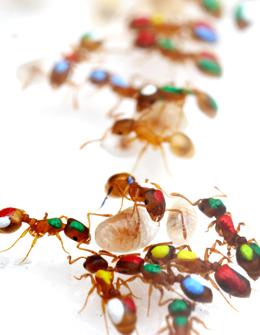Sterile workers can accrue reproductive benefits by helping their relatives.
Alex Wild
Altruistic behaviour, such as sterile worker ants caring for the offspring of their queen, evolves only between related individuals through what is known as kin selection — or so many evolutionary biologists have thought since the 1960s.
They argue that the standard theory of natural selection cannot explain the evolution of eusocial groups of organisms such as bees and ants, because the sterile workers in those groups do not themselves reproduce.
A two-part mathematical analysis, published in Nature this week, overturns this tenet by showing that it is possible for eusocial behaviour to evolve through standard natural-selection processes.
Reproductive benefits
Kin selection is based on 'inclusive fitness', the idea that, for example, sterile workers can accrue reproductive benefits by helping their relatives. In doing so, they help shared genes to survive and get passed on to the next generation. This provides a route for eusociality to evolve.
But Martin Nowak, a mathematical biologist at Harvard University in Cambridge, Massachusetts, and the lead author of the analysis, says, "there is no need for inclusive fitness to explain eusociality".
Nowak and his team provide the first mathematical analysis of inclusive fitness theory. They calculated which of two behaviours, for example defection — such as going off to set up a separate colony — or cooperation would become more prevalent in a population if standard natural selection was at work. They then worked out what assumptions would be needed for inclusive fitness theory to deliver the same result.
The team discovered that inclusive fitness delivers the same result only in a limited set of specific situations that would rarely hold in reality. For example, inclusive fitness worked only if the two behaviours were very similar — so that the pressure to select one over the other is vanishingly small — and if just two individuals were interacting at one time.
And when the inclusive fitness theory worked, the answer that it provided was mathematically equivalent to that derived from standard natural selection.
"We show that inclusive fitness is not a general theory of evolution as its proponents had claimed," says Nowak. "In the limited domain where inclusive fitness theory does work, it is identical to standard natural selection. Hence there is no need for inclusive fitness. It has no explanatory power."
In a second mathematical analysis, the team investigated how eusociality could evolve through standard natural selection. They found that a gene for eusociality could spread readily as long as the advantages it confers — increasing the lifespan and reproductive success of the queen — kick in even for small colonies. So colonies that have as few as two or three workers must provide significant advantages to their queen for the gene and the behaviour to become widespread.
"Whether or not eusociality evolves depends on how colony size affects the mortality and fecundity of the queen," says Nowak. "Our model also shows that eusociality is hard to evolve but is very stable once it is established."
Sparking controversy
The analyses have begun to spark controversy among scientists who are already highly divided on the issue of how altruistic behaviours evolve.
David Sloan Wilson, an evolutionary biologist at Binghamton University in New York, says that Nowak's paper "knocks inclusive fitness off its perch".
But he adds that "there is still a seat at the table for inclusive fitness. It can be used as a rule of thumb about when something might evolve."
Samir Okasha, a philosopher of biology at the University of Bristol, UK, agrees with the paper that inclusive fitness models rely on certain assumptions but says that these assumptions "are not as limiting" as the paper suggests.
The paper "neglects to say that inclusive fitness is a way to explain why animals would harm their own reproductive success and the answer is that they are benefiting their relatives", he says.
Stu West, an evolutionary biologist at the University of Oxford, UK, says that the new analysis is "incorrect". He says that empirical data show that the route to eusociality is through offspring helping parents, rather than through females coming together to form groups, as he says that Nowak and his team suggest.
But Nowak says that eusociality implies that offspring stay with their parents and help them to reproduce, and so "relatedness is a consequence of eusociality". But, he asks, is it also a cause of eusociality? "The answer to the question is no."





Comments